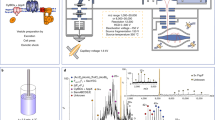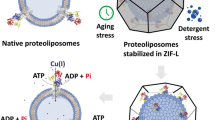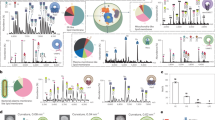Abstract
A procedure is described for the synthetic incorporation into membrane proteins of the non-natural amino acid TOAC (2,2,6,6-tetramethyl-piperidine-1-oxyl-4-amino-4-carboxylic acid), which is coupled rigidly to the α-carbon, providing direct detection of peptide backbone dynamics by electron paramagnetic resonance (EPR). Also included is a protocol for the functional reconstitution of the spin-labeled protein in lipid vesicles. This protocol can be completed in 17 d.
This is a preview of subscription content, access via your institution
Access options
Subscribe to this journal
Receive 12 print issues and online access
$259.00 per year
only $21.58 per issue
Buy this article
- Purchase on Springer Link
- Instant access to full article PDF
Prices may be subject to local taxes which are calculated during checkout






Similar content being viewed by others
References
Zamoon, J., Mascioni, A., Thomas, D.D. & Veglia, G. NMR solution structure and topological orientation of monomeric phospholamban in dodecylphosphocholine micelles. Biophys. J. 85, 2589–2598 (2003).
Lindemann, J.P., Jones, L.R., Hathaway, D.R., Henry, B.G. & Watanabe, A.M. β-Adrenergic stimulation of phospholamban phosphorylation and Ca2+- ATPase activity in guinea pig ventricles. J. Biol. Chem. 258, 464–471 (1983).
MacLennan, D.H. & Kranias, E.G. Phospholamban: a crucial regulator of cardiac contractility. Nature Rev. Mol. Cell Biol. 4, 566–577 (2003).
Haghighi, K. et al. Human phospholamban null results in lethal dilated cardiomyopathy revealing a critical difference between mouse and human. J. Clin. Invest. 111, 869–876 (2003).
Minamisawa, S. et al. Mutation of the phospholamban promoter associated with hypertrophic cardiomyopathy. Biochem. Biophys. Res. Commun. 304, 1–4 (2003).
Sande, J.B. et al. Reduced level of serine(16) phosphorylated phospholamban in the failing rat myocardium: a major contributor to reduced SERCA2 activity. Cardiovasc. Res. 53, 382–391 (2002).
Schmidt, A.G., Edes, I. & Kranias, E.G. Phospholamban: a promising therapeutic target in heart failure? Cardiovasc. Drugs Ther. 15, 387–396 (2001).
Minamisawa, S. et al. Chronic phospholamban-sarcoplasmic reticulum calcium ATPase interaction is the critical calcium cycling defect in dilated cardiomyopathy. Cell 99, 313–322 (1999).
Karim, C.B., Kirby, T.L., Zhang, Z., Nesmelov, Y. & Thomas, D.D. Phospholamban structural dynamics in lipid bilayers probed by a spin label rigidly coupled to the peptide backbone. Proc. Natl. Acad. Sci. USA 101, 14437–14442 (2004).
Karim, C.B., Marquardt, C.G., Stamm, J.D., Barany, G. & Thomas, D.D. Synthetic null-cysteine phospholamban analogue and the corresponding transmembrane domain inhibit the Ca-ATPase. Biochemistry 39, 10892–10897 (2000).
Karim, C.B. et al. Role of cysteine residues in structural stability and function of a transmembrane helix bundle. J. Biol. Chem. 26, 26 (2001).
Karim, C.B., Zhang, Z., Howard, E.C., Torgersen, K.D. & Thomas, D.D. Phosphorylation-dependent conformational switch in spin-labeled phospholamban bound to SERCA. J. Mol. Biol. 358, 1032–1040 (2006).
Muir, T.W. & Kent, S.B. The chemical synthesis of proteins. Curr. Opin. Biotechnol. 4, 420–427 (1993).
Coin, I. et al. Depsipeptide methodology for solid-phase peptide synthesis: circumventing side reactions and development of an automated technique via depsidipeptide units. J. Org. Chem. 71, 6171–6177 (2006).
Sarin, V.K., Kent, S.B., Tam, J.P. & Merrifield, R.B. Quantitative monitoring of solid-phase peptide synthesis by the ninhydrin reaction. Anal. Biochem. 117, 147–157 (1981).
Zamoon, J., Nitu, F., Karim, C., Thomas, D.D. & Veglia, G. Mapping the interaction surface of a membrane protein: unveiling the conformational switch of phospholamban in calcium pump regulation. Proc. Natl. Acad. Sci. USA 102, 4747–4752 (2005).
Metcalfe, E.E., Traaseth, N.J. & Veglia, G. Serine 16 phosphorylation induces an order-to-disorder transition in monomeric phospholamban. Biochemistry 44, 4386–4396 (2005).
Robia, S.L., Flohr, N.C. & Thomas, D.D. Phospholamban pentamer quaternary conformation determined by in-gel fluorescence anisotropy. Biochemistry 44, 4302–4311 (2005).
Mueller, B., Karim, C.B., Negrashov, I.V., Kutchai, H. & Thomas, D.D. Direct detection of phospholamban and sarcoplasmic reticulum Ca-ATPase interaction in membranes using fluorescence resonance energy transfer. Biochemistry 43, 8754–8765 (2004).
Tatulian, S.A. et al. The inhibitory action of phospholamban involves stabilization of alpha-helices within the Ca-ATPase. Biochemistry 41, 741–751 (2002).
Paterlini, M.G. & Thomas, D.D. The alpha-helical propensity of the cytoplasmic domain of phospholamban: a molecular dynamics simulation of the effect of phosphorylation and mutation. Biophys. J. 88, 3243–3251 (2005).
Lockwood, N.A. et al. Structure and function of integral membrane protein domains resolved by peptide-amphiphiles: application to phospholamban. Biopolymers 69, 283–292 (2003).
Kirby, T.L., Karim, C.B. & Thomas, D.D. Electron paramagnetic resonance reveals a large-scale conformational change in the cytoplasmic domain of phospholamban upon binding to the sarcoplasmic reticulum Ca-ATPase. Biochemistry 43, 5842–5852 (2004).
Negash, S. et al. Phospholamban remains associated with the Ca2+- and Mg2+-dependent ATPase following phosphorylation by cAMP-dependent protein kinase. Biochem. J. 351, 195–205 (2000).
Chen, B. & Bigelow, D.J. Phosphorylation induces a conformational transition near the lipid-water interface of phospholamban reconstituted with the Ca-ATPase. Biochemistry 41, 13965–13972 (2002).
Hubbell, W.L., Cafiso, D.S. & Altenbach, C. Identifying conformational changes with site-directed spin labeling. Nature Struct. Biol. 7, 735–739 (2000).
Monaco, V. et al. Determining the occurrence of a 3(10)-helix and an alpha-helix in two different segments of a lipopeptaibol antibiotic using TOAC, a nitroxide spin-labeled C(alpha)-tetrasubstituted alpha-aminoacid. Bioorg. Med. Chem. 7, 119–131 (1999).
Monaco, V. et al. Orientation and immersion depth of a helical lipopeptaibol in membranes using TOAC as an ESR probe. Biopolymers 50, 239–253 (1999).
Toniolo, C. et al. Synthesis and conformational studies of peptides containing TOAC, a spin-labelled C alpha, alpha-disubstituted glycine. J. Pept. Sci. 1, 45–57 (1995).
Toniolo, C., Crisma, M. & Formaggio, F. TOAC, a nitroxide spin-labeled, achiral C-tetrasubstituted-amino acid, is an excellent tool in material science and biochemistry. Pept. Sci. 47, 153–158 (1998).
Atherton, E. & Sheppard, R.C. Solid Phase Peptide Synthesis. A Practical Approach (IRL Press, Oxford, 1989).
Martin, L., Ivancich, A., Vita, C., Formaggio, F. & Toniolo, C. Solid-phase peptide synthesis of peptides containing the spin-labeled 2,2,6,6-tetramethylpiperidine-1-oxyl-4-amino-4-carboxylic acid (TOAC). Pept. Res. 58, 424–432 (2001).
Hanson, P. et al. Distinguishing helix conformations in alanine-rich peptides using the unnatural amino acid TOAC and electron spin resonance. J. Am. Chem. Soc. 118, 271–272 (1996).
Marchetto, R., Schreier, S. & Nakaie, C.R. A novel spin-labeled amino acid derivative for use in peptide chemistry: (9-fluorenylmethyloxycarbonyl)2,2,6,6-tetramethylpiperidine-N-oxyl-4-amino-4-carboxylic acid. J. Am. Chem. Soc. 115, 11042–11043 (1993).
McNulty, J.C., Thompson, D.A., Carrasco, M.R. & Millhauser, G.L. Dap-SL: a new site-directed nitroxide spin labeling approach for determining structure and motions in synthesized peptides and proteins. FEBS Lett. 529, 243–248 (2002).
Bui, T.T. et al. TOAC: a useful C-alpha-tetrasubstituted-amino acid for peptide conformational analysis by CD spectroscopy in the visible region. J. Chem. Soc., Perkin Trans. 2, 1043–1046 (2000).
Hanson, P. et al. Electron spin resonance and structural analysis of water soluble, alanine-rich peptides incorporating TOAC. Mol. Physics 95, 957–966 (1998).
Nakaie, C.R., Goissis, G., Schreier, S. & Paiva, A.C. pH dependence of EPR spectra of nitroxides containing ionizable groups. Braz. J. Med. Biol. Res. 14, 173–180 (1981).
Nakaie, C.R., Schreier, S. & Paiva, A.C. Synthesis and properties of spin-labeled angiotensin derivatives. Biochim. Biophys. Acta 742, 63–71 (1983).
Nakaie, C.R. et al. Synthesis and pharmacological properties of TOAC-labeled angiotensin and bradykinin analogs. Peptides 23, 65–70 (2002).
MirAfzali, Z., Leipprandt, J.R., McCracken, J.L. & DeWitt, D.L. Fast, efficient reconstitution of the cyclooxygenases into proteoliposomes. Arch. Biochem. Biophys. 443, 60–65 (2005).
Zhang, Z., Remmer, H.A., Thomas, D.D. & Karim, C.B. Backbone dynamics determined by electron paramagnetic resonance to optimize solid-phase peptide synthesis of TOAC-labeled phospholamban. Biopolymers 88, 29–35 (2006).
Carpino, L.A. 1-Hydroxy-7-azabenzotriazole. An efficient peptide coupling additive. J. Am. Chem. Soc. 115, 4397–4398 (1993).
Chan, W.C. & White, P.D. Fmoc Solid Phase Peptide Synthesis 1–341 (Oxford University Press, Oxford, 2000).
Wade, J.D., Bedford, J., Sheppard, R.C. & Tregear, G.W. DBU as an N alpha-deprotecting reagent for the fluorenylmethoxycarbonyl group in continuous flow solid-phase peptide synthesis. Pept. Res. 4, 194–199 (1991).
Lowry, O.H., Rosebrough, N.J., Farr, A.L. & Randall, R.J. Protein measurement with the Folin phenol reagent. J. Biol. Chem. 193, 265–275 (1951).
Hartree, E.F. Determination of protein: a modification of the Lowry method that gives a linear photometric response. Anal. Biochem. 48, 422–427 (1972).
Dulley, J.R. & Grieve, P.A. A simple technique for eliminating interference by detergents in the Lowry method of protein determination. Anal. Biochem. 64, 136–141 (1975).
Sheldon, R.A. & Arends, I.W.C.E. Organocatalytic oxidations mediated by nitroxyl radicals. Adv. Synth. Catal. 346, 1051–1071 (2004).
Tominaga, M. et al. Fmoc-POAC: [(9-fluorenylmethyloxycarbonyl)-2,2,5,5-tetramethylpyrrolidine-N-oxyl-3-amino-4-carboxylic acid]: a novel protected spin labeled beta-amino acid for peptide and protein chemistry. Chem. Pharm. Bull. (Tokyo) 49, 1027–1029 (2001).
Acknowledgements
The authors thank Henriette Remmer at the Department of Biological Chemistry, University of Michigan, for advice about experimental details. This work was supported by a grant from the National Institutes of Health to D.D.T. (GM27906).
Author information
Authors and Affiliations
Corresponding author
Ethics declarations
Competing interests
The authors declare no competing financial interests.
Rights and permissions
About this article
Cite this article
Karim, C., Zhang, Z. & Thomas, D. Synthesis of TOAC spin-labeled proteins and reconstitution in lipid membranes. Nat Protoc 2, 42–49 (2007). https://doi.org/10.1038/nprot.2007.2
Published:
Issue Date:
DOI: https://doi.org/10.1038/nprot.2007.2
This article is cited by
-
Structural Dynamics of Protein Interactions Using Site-Directed Spin Labeling of Cysteines to Measure Distances and Rotational Dynamics with EPR Spectroscopy
Applied Magnetic Resonance (2024)
-
Quantifying residue-specific conformational dynamics of a highly reactive 29-mer peptide
Scientific Reports (2020)
-
Structural dynamics of calmodulin-ryanodine receptor interactions: electron paramagnetic resonance using stereospecific spin labels
Scientific Reports (2018)
-
Structural Mechanism for Regulation of Bcl-2 protein Noxa by phosphorylation
Scientific Reports (2015)
-
The spin label amino acid TOAC and its uses in studies of peptides: chemical, physicochemical, spectroscopic, and conformational aspects
Biophysical Reviews (2012)
Comments
By submitting a comment you agree to abide by our Terms and Community Guidelines. If you find something abusive or that does not comply with our terms or guidelines please flag it as inappropriate.



